MARBLE FLOORING
UNDERSTANDING YOUR MARBLE FLOORING: Marble is a very popular natural stone that is quarried and cut into slabs and tiles for a variety of residential and commercial building applications, including countertops, floors, and wall tiles. It is a metamorphic rock that forms when a sedimentary stone, such as limestone, is transformed under heat and pressure into a harder stone with beautiful color and veined patterns. Marble is sometimes confused with granite, however, granite is an igneous rock derived from volcanic magma, not layered sedimentary rock. Granite typically has a pebbly or spotted color pattern, while marble usually has a wavy veined pattern.
Marble, quarried in mountainous regions around the world, has been a very popular building material for millennia. Prized for its beauty, style, and elegance, this material has graced the palaces of kings and queens for centuries, making it an upscale, luxurious option for interiors.
Marble, quarried in mountainous regions around the world, has been a very popular building material for millennia. Prized for its beauty, style, and elegance, this material has graced the palaces of kings and queens for centuries, making it an upscale, luxurious option for interiors.

FEATURES:
• Elegant, upscale appearance
• Natural material
• Easily polished
• Accommodates radiant floor heating
• Adds real estate value
SPECIFICATIONS:
• Porous stone requires sealing
• Scratches, stains easily
• Expensive
• Slippery and brittle
• Cold underfoot
• Elegant, upscale appearance
• Natural material
• Easily polished
• Accommodates radiant floor heating
• Adds real estate value
SPECIFICATIONS:
• Porous stone requires sealing
• Scratches, stains easily
• Expensive
• Slippery and brittle
• Cold underfoot
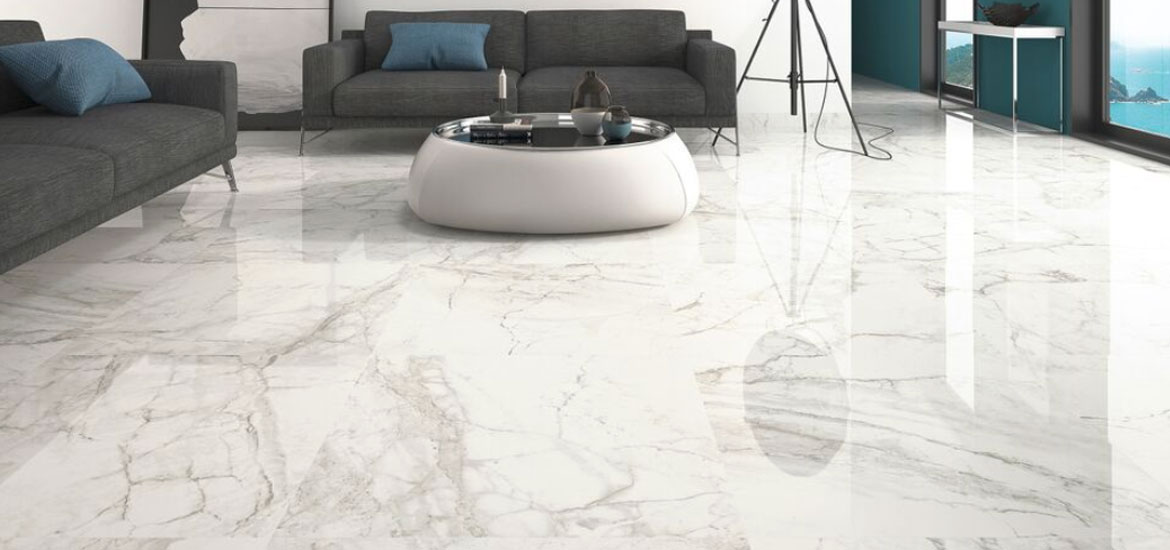
Marble Flooring Cost:
Marble floors are a premium architectural element, and they are priced accordingly. Generally, they fall on the high-end range of all-natural stone, and they generally do not last as long as slate, granite, and other natural stone. Ceramic tile is typically about half the cost of marble, although the cost of installation labor is fairly comparable.
Marble floors are a premium architectural element, and they are priced accordingly. Generally, they fall on the high-end range of all-natural stone, and they generally do not last as long as slate, granite, and other natural stone. Ceramic tile is typically about half the cost of marble, although the cost of installation labor is fairly comparable.
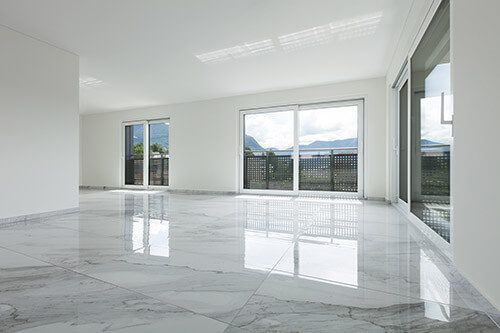
Maintenance and Repair:
Once installed, routine maintenance of a marble tile floor is relatively easy—it requires the same kind of sweeping and damp mopping you would do with a ceramic tile floor. However, unlike ceramic tile, marble is fairly porous, so you shouldn’t allow water to puddle and stand on the surface. Standing water can penetrate the stone and discolor it.
Marble has a pH on the base (alkaline) side, due to its origin as a sedimentary limestone. This means that it can have a chemical reaction whenever it comes in contact with acidic substances. This can include a wide variety of foods, sauces, beverages, and cleaning products. Unfortunately, the discoloration stains that come from these materials are usually permanent. This can be prevented by applying a chemical penetrating sealer, as well as a surface sealer after installation. But for optimal protection, the surface sealer needs to be reapplied annually.
Even though it is stone, marble is actually a relatively soft material that can be scratched, scraped, and chipped under the wrong conditions. This is especially true if the material is polished, as the imperfections will be more noticeable in the smooth, flat solid surface.
Once installed, routine maintenance of a marble tile floor is relatively easy—it requires the same kind of sweeping and damp mopping you would do with a ceramic tile floor. However, unlike ceramic tile, marble is fairly porous, so you shouldn’t allow water to puddle and stand on the surface. Standing water can penetrate the stone and discolor it.
Marble has a pH on the base (alkaline) side, due to its origin as a sedimentary limestone. This means that it can have a chemical reaction whenever it comes in contact with acidic substances. This can include a wide variety of foods, sauces, beverages, and cleaning products. Unfortunately, the discoloration stains that come from these materials are usually permanent. This can be prevented by applying a chemical penetrating sealer, as well as a surface sealer after installation. But for optimal protection, the surface sealer needs to be reapplied annually.
Even though it is stone, marble is actually a relatively soft material that can be scratched, scraped, and chipped under the wrong conditions. This is especially true if the material is polished, as the imperfections will be more noticeable in the smooth, flat solid surface.

Design:
The biggest advantage of marble floor tiles is that it instantly elevates the appearance of a space, giving it a regal bearing that is hard to imitate. And marble is available in multiple colors, and even in stunning multicolor mixes, providing flexible options for a variety of decorative schemes. Tiles can also be cut to rectangles and triangles of varying sizes in order to create complex mosaic installations.
Because it is a product of the earth, every piece of marble tile used in every single floor is one-of-a-kind; there is no other like it anywhere in the world. In the case of multi-colored marble, this uniqueness can be quite pronounced, with distinct features blaring forth from every tile. With more solid-colored marble, the color differences shifts are much more subtle and subdued, but your floor will still stand out with its own personality.
Unlike most natural stones, marble is able to take a very high polish, achieving a silky smooth and shimmering look when treated properly. This look of sophistication and glamor evokes the highest sense of elegance in a space.
The biggest advantage of marble floor tiles is that it instantly elevates the appearance of a space, giving it a regal bearing that is hard to imitate. And marble is available in multiple colors, and even in stunning multicolor mixes, providing flexible options for a variety of decorative schemes. Tiles can also be cut to rectangles and triangles of varying sizes in order to create complex mosaic installations.
Because it is a product of the earth, every piece of marble tile used in every single floor is one-of-a-kind; there is no other like it anywhere in the world. In the case of multi-colored marble, this uniqueness can be quite pronounced, with distinct features blaring forth from every tile. With more solid-colored marble, the color differences shifts are much more subtle and subdued, but your floor will still stand out with its own personality.
Unlike most natural stones, marble is able to take a very high polish, achieving a silky smooth and shimmering look when treated properly. This look of sophistication and glamor evokes the highest sense of elegance in a space.

Marble Flooring Installation:
Marble tile is installed in much the same way as ceramic or any other natural stone tile. A layer of cement board (backer board) is first laid over the subfloor, and then the tiles are glued down with a thin-set adhesive. After the adhesive dries, the joints between the tiles are filled with a cementations grout. But unlike most ceramic tile, which requires only that the grout lines be sealed, marble requires that the entire surface be sealed immediately after installation, then every year or so after that.
Marble tile is installed in much the same way as ceramic or any other natural stone tile. A layer of cement board (backer board) is first laid over the subfloor, and then the tiles are glued down with a thin-set adhesive. After the adhesive dries, the joints between the tiles are filled with a cementations grout. But unlike most ceramic tile, which requires only that the grout lines be sealed, marble requires that the entire surface be sealed immediately after installation, then every year or so after that.
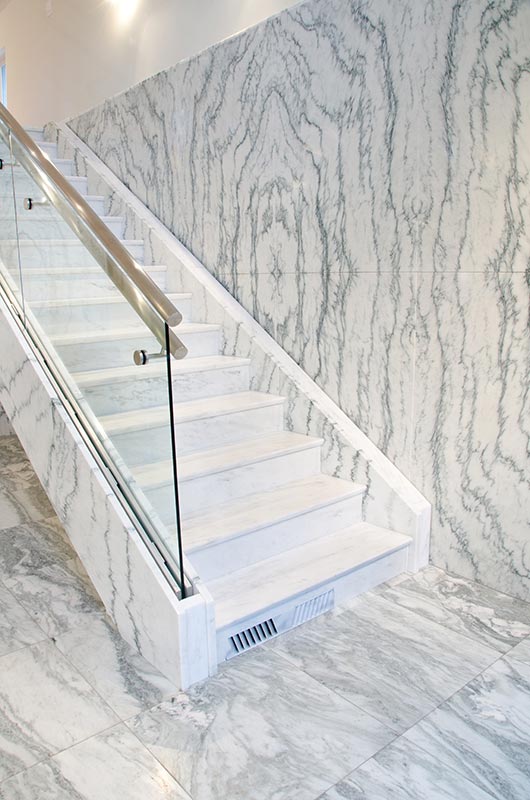
Marble vs. Porcelain Tile Flooring:
Many of the same virtues found with marble floor tile can be achieved with porcelain tiles. While the subtle veining of marble makes for a completely unique floor, a remarkably similar look can be achieved by modern porcelain tiles, which now can be manufactured to realistically mimic a wide variety of materials, including natural stone and wood. While some people will be able to tell the difference, a porcelain tile floor can create a look that is very nearly identical—especially if a skilled installer has paid attention to laying out the tiles so the simulated veining patterns are convincingly random.
Many of the same virtues found with marble floor tile can be achieved with porcelain tiles. While the subtle veining of marble makes for a completely unique floor, a remarkably similar look can be achieved by modern porcelain tiles, which now can be manufactured to realistically mimic a wide variety of materials, including natural stone and wood. While some people will be able to tell the difference, a porcelain tile floor can create a look that is very nearly identical—especially if a skilled installer has paid attention to laying out the tiles so the simulated veining patterns are convincingly random.

Top Brands of Marble Flooring:
• Carrara Marble: This is the most common type of marble, quarried in the Carrara region of Italy. In color, it is grayish-white with soft, feathery gray veining. It is by far the most common type used in flooring applications since it is fairly economical.
• Carrara Marble: This is the most common type of marble, quarried in the Carrara region of Italy. In color, it is grayish-white with soft, feathery gray veining. It is by far the most common type used in flooring applications since it is fairly economical.

• Calacatta Marble: This marble falls at the other end of the spectrum, as the most luxurious and expensive, thanks to its rarity. Although it is similar in appearance to Carrara Marble, it has much darker, thick veining patterns over a bright white background. There is also a variation with very beautiful gold hues in the veining. Calacatta marble comes from specific quarries in the Carrara region of Italy.

• Statuario Marble: This is also similar in appearance to Carrara, but it has a more translucent white background and more dramatic veining, which gives it a more luxurious feeling. This marble comes from the Carrara region of Italy, but north of the region where Carrara and Calacatta marble are quarried.
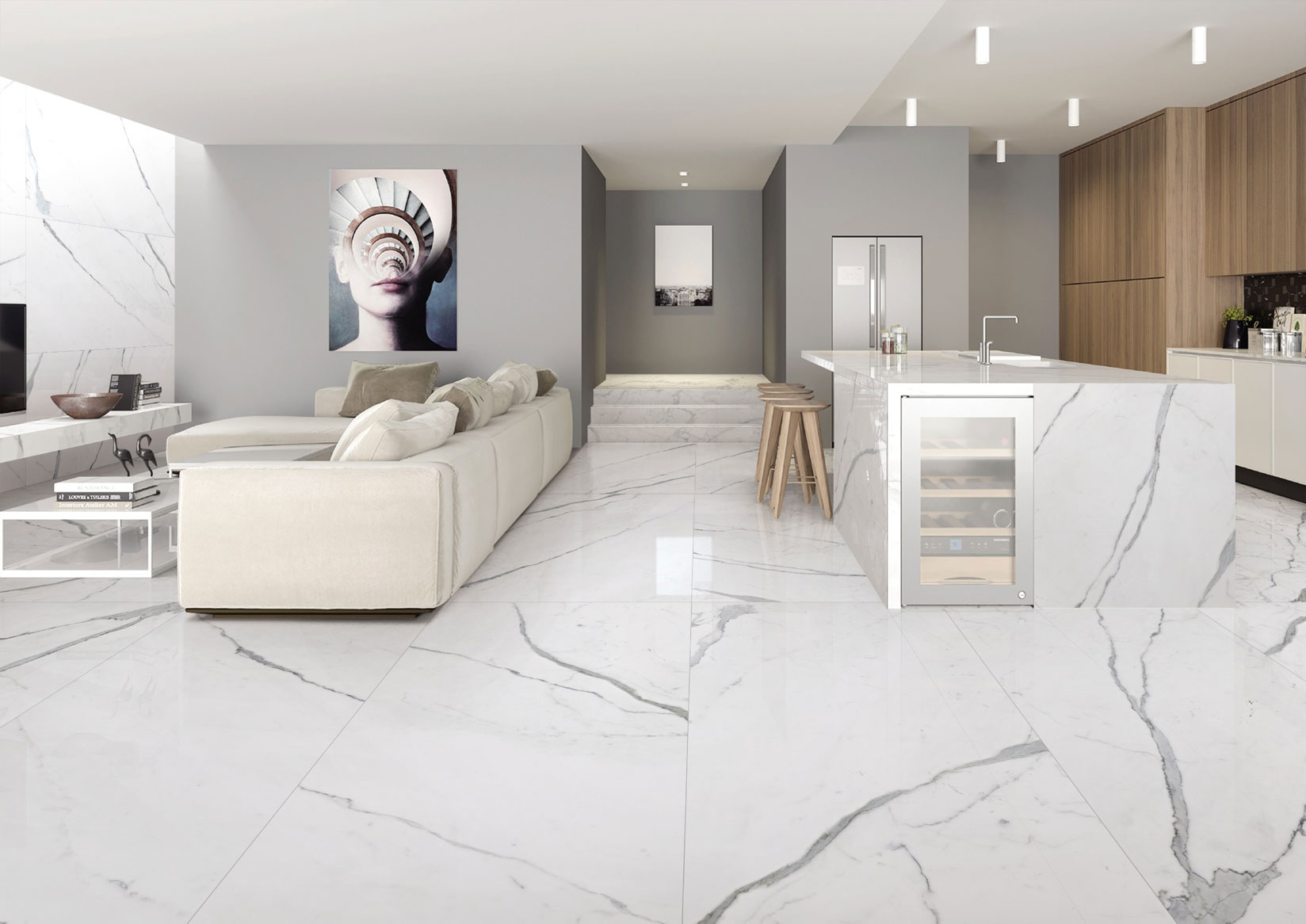
• Emperador Marble: This type is quarried in Spain, and comes in various shades of brown, with irregular veining.

• Crema Marfil Marble: Also from Spain, crema Marfil comes in many color variations, with the most common being beige or yellowish with veining that varies in intensity.

Comfort and Convenience:
When polished, marble can be a dangerously slick and slippery surface. In kitchens and bathrooms where water is likely, this can be a problem, since these floors are unforgiving on bones and joints in the event of a fall. Use non-slip rugs in these areas if you are using highly polished marble, or opt for less polished forms of marble tile.
When polished, marble can be a dangerously slick and slippery surface. In kitchens and bathrooms where water is likely, this can be a problem, since these floors are unforgiving on bones and joints in the event of a fall. Use non-slip rugs in these areas if you are using highly polished marble, or opt for less polished forms of marble tile.
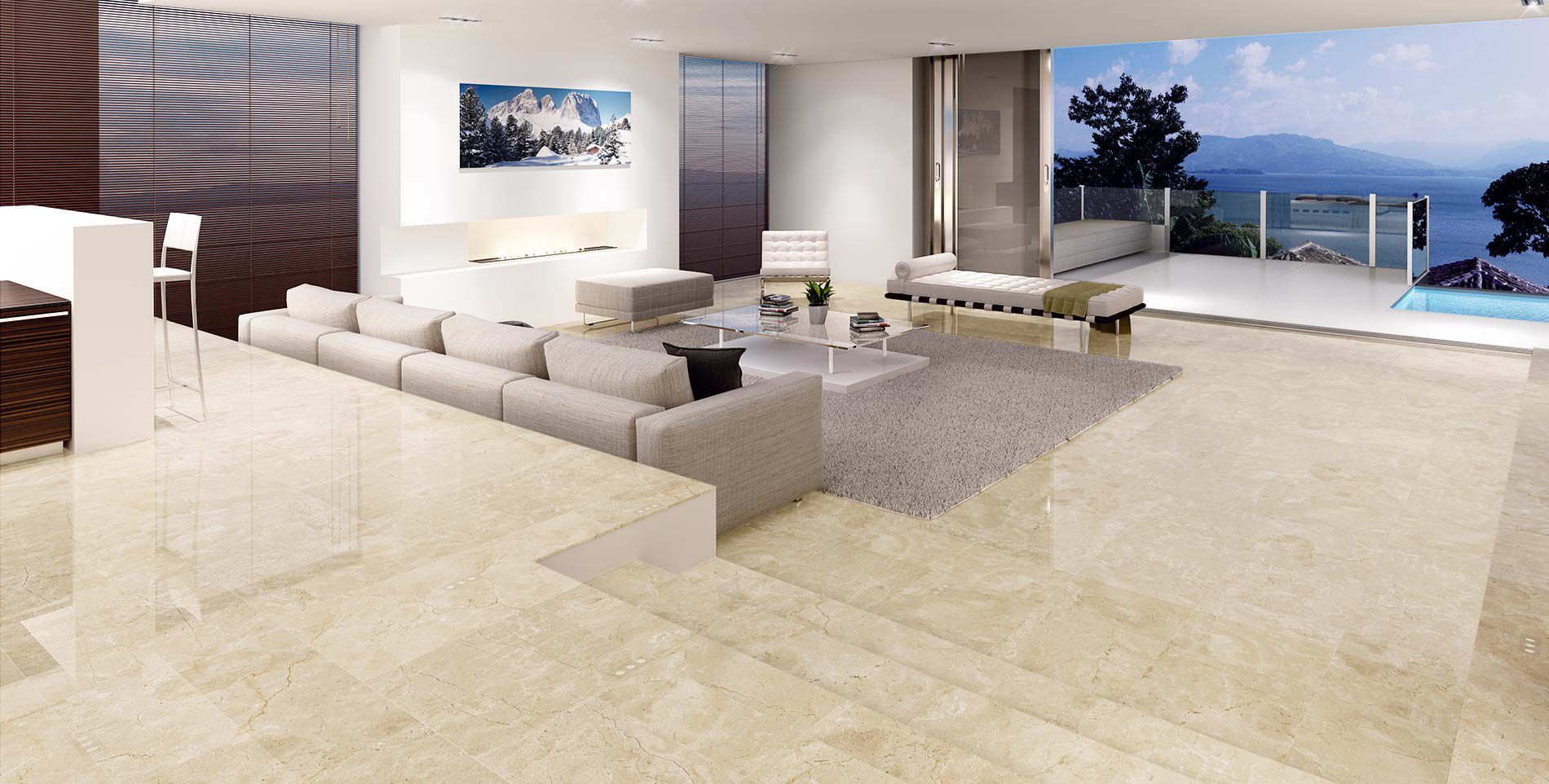
CONTACT US ON; 9829040013

Comments
Post a Comment